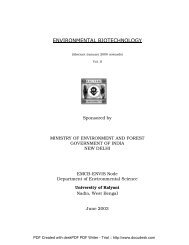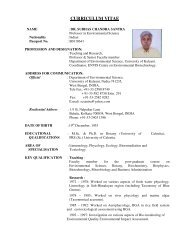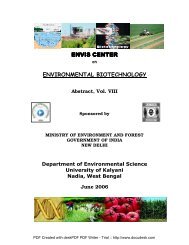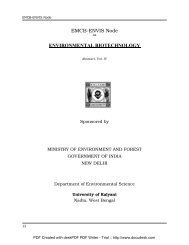EMCB-ENVIS Node ENVIRONMENTAL BIOTECHNOLOGY
EMCB-ENVIS Node ENVIRONMENTAL BIOTECHNOLOGY
EMCB-ENVIS Node ENVIRONMENTAL BIOTECHNOLOGY
Create successful ePaper yourself
Turn your PDF publications into a flip-book with our unique Google optimized e-Paper software.
<strong>EMCB</strong>-<strong>ENVIS</strong> Centre<br />
concentration levels of these heavy metals in normal soil. This situation indicates that there is<br />
heavy metal pollution in the inspected area in E-5 Highway in Istanbul.<br />
Nakajima Akira. (Department of Chemistry, Faculty of Medicine, Miyazaki Medical College,<br />
Kiyotake, Miyazaki 889 16, Japan). Accumulation of gold by microorganisms . Journal<br />
of Microbiology and Biotechnology, 19(4) (2003), 369-374.<br />
Thirty species of microorganisms (8 bacteria, 9 actinomycetes, 8 fungi and 5 yeasts) were<br />
screened for maximal gold accumulation. Extremely high abilities to accumulate gold from a<br />
solution containing hydrogen tetrachloroaurate(III) were found in bacterial strains, such as<br />
Escherichia coli and Pseudomonas maltophilia. Most of the actinomycetes, fungi and yeasts had<br />
lower ability to accumulate gold than bacteria. Some microorganisms could accumulate similar<br />
amounts of gold from a solution containing sodium gold(I) thiomalate as those from gold(III)<br />
solution. However, most microorganisms tested accumulated far lesser amounts of gold from a<br />
solution containing sodium dicyanoaurate(I) than from the other two gold solutions. The<br />
accumulation of gold from the solution containing hydrogen tetrachloroaurate(III) by<br />
Pseudomonas maltophilia was very rapid, was affected by the pH of the solution, and obeyed the<br />
Langmuir adsorption isotherm. Pseudomonas maltophilia cells immobilized in polyacrylamide<br />
gel adsorbed gold effectively from the solution containing hydrogen tetrachloroaurate(III). The<br />
gold adsorbed on the cells was easily desorbed with 0.1 M thiourea solution. The immobilized<br />
Pseudomonas cells could be used repeatedly in the adsorption–desorption cycle using 0.1 M<br />
thiourea solution as desorbent.<br />
O. S. Okay, P. Donkin, L. D Peters, D. R Livingstone. (TÜB TAK, MRC, Energy Systems and<br />
Environmental Research Institute, PO Box 21, 41470, Gebze, Kocaeli, Turkey. CCMS,<br />
Plymouth Marine Laboratory, Prospect Place, The Hoe, Plymouth PL1 3DH, UK. CCMS,<br />
Plymouth Marine Laboratory, Citadel Hill, Plymouth PL1 2PB, UK). The role of algae<br />
(Isochrysis galbana) enrichment on the bioaccumulation of benzo[a]pyrene and<br />
its effects on the blue mussel Mytilus edulis. Environmental Pollution, 110(1) (2000),<br />
103-113.<br />
The role of algal concentration in the transfer of organic contaminants in a food chain has been<br />
studied using the ubiquitous model polycyclic aromatic hydrocarbon benzo[a]pyrene (BaP) as<br />
the contaminant, Isochrysis galbana as the phytoplankton food source, and the common mussel<br />
(Mytilus edulis) as the primary consumer. The effect of algal concentration on BaP uptake by M.<br />
edulis was determined by feeding M. edulis daily with I. galbana which had previously been<br />
kept in the presence of BaP for 24 h. Four combinations of concentrations of algae and BaP were<br />
used to give final exposure concentrations of 30,000 or 150,000 algal cells ml -1 in combination<br />
with either 2 or 50 μg BaP l -1 . BaP concentrations were determined fluorometrically in rest<br />
tissues (excluding digestive glands) and digestive gland microsomal fractions of M. edulis after<br />
1, 7 and 15 days exposure, and also in isolated algae. Potentially toxic effects of BaP on M.<br />
edulis were examined in terms of blood cell lysosomal membrane damage (neutral red dye<br />
retention assay) and induction of digestive gland microsomal mixed-function oxygenase (MFO)<br />
parameters [BaP hydroxylase (BPH) and NADPH-cytochrome c (P450) reductase activities].<br />
BaP bioaccumulation in rest tissues (and to a lesser extent in digestive gland microsomes) of M.<br />
edulis increased with both increasing BaP and algal exposure concentrations, and over time,<br />
producing maximal bioconcentration factors in rest tissues after 15 days exposure to 150,000<br />
algal cells ml -1 and 50 μg BaP l -1 of 250,000. The five-fold higher concentration of algae<br />
increased BaP bioaccumulation by a factor of approximately 2 for 50 μg BaP l -1 at day 15. Blood<br />
cell neutral red dye retention time decreased linearly with increasing log10 tissue BaP body<br />
burden, indicating an increased biological impact on M. edulis with increasing BaP exposure<br />
possibly due to a direct effect of BaP on blood cell lysosomal membrane integrity. An increase<br />
36<br />
PDF Created with deskPDF PDF Writer - Trial :: http://www.docudesk.com







